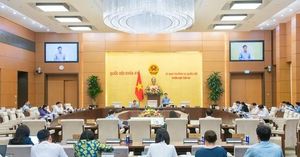Spring is bringing warmth to South Korea, but with it, yellow dust—a seasonal menace—is negatively impacting air quality nationwide. On March 14, 2025, the country prepares for the adverse effects of yellow dust, which is expected to push the fine dust concentration to troubling 'bad' levels, prompting health advisories across various sectors.
According to recent forecasts, following the clear weather predicted for March 14, air pollution levels are projected to rise significantly, particularly due to yellow dust infiltrated by northwestern winds from Northeast Asia. The Daejeon Regional Meteorological Administration noted, "The impact of yellow dust may vary depending on wind patterns," highlighting the unpredictability of this natural phenomenon.
The atmosphere is expected to feel much heavier on this day, as fine dust concentration readings have already revealed alarming figures. For example, as of 5 PM on March 13, 2025, the fine dust concentration at Songsan-myeon, located within Dangjin City, recorded 201 micrograms per cubic meter, categorizing it as 'very bad' levels.
While the weather on March 14 is expected to be mostly clear, communities across the region remain vigilant due to the fierce arrival of yellow dust. Although the cardiologists recommend outdoor avoidance for the elderly and people with respiratory issues, many citizens have ventured outside with face masks, showcasing caution and concern. A resident of Daejeon remarked, "My husband saw on TV how bad the yellow dust was today, so he insisted I wear a mask before going out."
The phenomenon of yellow dust should not be confused with typical air pollution. Yellow dust is made up of larger particles originating from the deserts of China and Mongolia, where dust storms can lift soil particles, carried by wind across borders, affecting air quality strongly. Fine dust, on the other hand, consists of smaller pollution byproducts from traffic and industry. Understanding this difference is pivotal as efforts are underway to curb both issues. Notably, South Korea ranks third among OECD countries for particulate matter concentrations, with the government aiming to reduce ultrafine dust levels to 13 micrograms by 2029.
People are still expected to experience mild weather conditions on March 14, with afternoon temperatures reaching highs between 11 and 21 degrees Celsius, noticeably rising above average. Most regions, except Jeju Island, will enjoy clear skies, but residents are advised to wear masks as yellow dust continues to linger across many parts.
Areas including Daejeon, Gwangju, and Jeonbuk will see fine dust levels temporarily escalate to 'bad' due to yellow dust still circulating from previous activations. Air quality experts advise the public to take additional precautions when venturing outdoors during these moments, reflecting the need for consistent vigilance as the season progresses.
Health officials highlight preventative measures like wearing quality face masks, keeping indoor air clean by closing windows, and utilizing air purifiers to combat the effects of yellow dust particles. Following the advice, experts also recommend frequent hand washing, thorough cleaning of clothing once returning indoors, and using artificial tears for eye comfort if irritation occurs.
On top of facing yellow dust, citizens should remain aware of their surroundings as weather forecasts predict the possibility of rain or snow over the weekend, which could impact the following week, bringing both relief from airborne dust and dropping temperatures afterwards.
Overall, the season of change brings with it caution and preparation, proving once again how interconnected weather patterns, public health, and community actions are, especially as South Koreans learn to navigate the challenges posed by both yellow dust and fine dust as part of their spring season routines.



